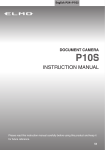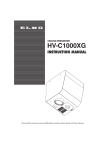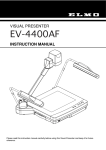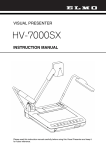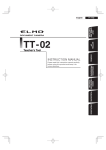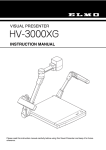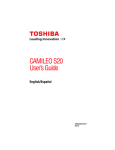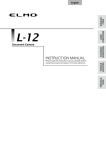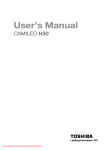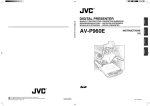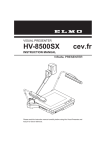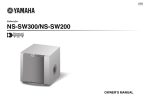Download Elmo P10 Instruction manual
Transcript
Français P000~P000 Français P000~P000 Deutch P000~P000 Deutch P000~P000 English P54~P105 P00~P00 VISUAL PRESENTER INSTRUCTION MANUAL Please read this instruction manual carefully before using this product and keep it for future reference. 54 ENGLISH IMPORTANT SAFEGUARDS ■ Read Instructions – All the safety and operating instructions should be read before the appliance is operated. ■ Retain Instructions – The safety and operating instructions should be retained for future reference. ■ Heed Warnings – All warnings on the product and in the operating instructions should be adhered to. ■ Follow Instructions – All operating and use instructions should be followed. ■ Cleaning – Unplug this product from the wall outlet before cleaning. Do not use liquid cleaners or aerosol cleaners. Use a damp cloth for cleaning. ■ Attachments – Do not use attachments not recommended by the product manufacturer as they may cause hazards. ■ Water and Moisture – Do not use this product near water - for example, near a bath tub, wash bowl, kitchen sink, or laundry tub, in a wet basement, or near a swimming pool, and the like. ■ Placement – Do not place this product on an unstable cart, stand, tripod, bracket, or table. The product may fall, causing serious injury to a child or adult, and serious damage to the product. Use only with a cart, stand, tripod, bracket, or table recommended by the manufacturer, or sold with the product. Any mounting of the product should follow the manufacturer's instructions, and should use a mounting accessory recommended by the manufacturer. 55 ■ Ventilation – Slots and openings in the cabinet are provided for ventilation and to ensure reliable operation of the product and to protect it from overheating, and these openings must not be blocked or covered. The openings should never be blocked by placing the product on a bed, sofa, rug, or other similar surface. This product should not be placed in a built-in installation such as a bookcase or rack unless proper ventilation is provided or the manufacturer's instructions have been adhered to. ■ Power Sources – This product should be operated only from the type of power source indicated on the marking label. If you are not sure of the type of power supply to your home consult your appliance dealer or local power company. For products intended to operate from battery power, or other sources, refer to the operating instructions. ENGLISH ■ Grounding or Polarization – This product may be equipped with either a polarized 2-wire AC line plug (a plug having one blade wider than the other) or a 3-wire grounding type plug, a plug having a third (grounding) pin. The 2-wire polarized plug will fit into the power outlet only one way. This is a safety feature. If you are unable to insert the plug fully into the outlet, try reversing the plug. If the plug still fails to fit, contact your electrician to replace your obsolete outlet. Do not defeat the safety purpose of the polarized plug. The 3wire grounding type plug will fit into a grounding type power outlet. This is a safety feature. If you are unable to insert the plug into the outlet, contact your electrician to replace your obsolete outlet. Do not defeat the safety purpose of the grounding type plug. ■ A product and cart combination should be moved with care. Quick stops, excessive force, and uneven surfaces may cause the product and cart combination to overturn. ■ Object and Liquid Entry – Never push objects of any kind into this product through openings as they may touch dangerous voltage points or short-out parts that could result in a fire or electric shock. Never spill liquid of any kind on the product. ■ Servicing – Do not attempt to service this product yourself as opening or removing covers may expose you to dangerous voltage or other hazards. Refer all servicing to qualified service personnel. ■ Power-Cord Protection – Powersupply cords should be routed so that they are not likely to be walked on or pinched by items placed upon or against them, paying particular attention to cords at plugs, convenience receptacles, and the point where they exit from the product. ■ Lightning – For added protection for this product during a lightning storm, or when it is left unattended and unused for long periods of time, unplug it from the wall outlet and disconnect the antenna or cable system. This will prevent damage to the product due to lightning and power-line surges. ■ Overloading – Do not overload wall outlets, extension cords, or integral convenience receptacles as this can result in a risk of fire or electric shock. 56 ENGLISH ■ Damage Requiring Service – Unplug this product from the wall outlet and refer servicing to qualified service personnel under the following conditions: ● When the power-supply cord or plug is damaged. ● If liquid has been spilled, or objects have fallen into the product. ● If the product has been exposed to rain or water. ● If the product does not operate normally by following the operating instructions. Adjust only those controls that are covered by the operating instructions as an improper adjustment of other controls may result in damage and will often require extensive work by a qualified technician to restore the product to its normal operation. ● If the product has been dropped or damaged in any way. ● When the product exhibits a distinct change in performance this indicates a need for service. ■ Replacement Parts – When replacement parts are required, be sure the service technician has used replacement parts specified by the manufacturer or have the same characteristics as the original part. Unauthorized substitutions may result in fire, electric shock or other hazards. ■ Safety Check – Upon completion of any service or repairs to this product, ask the service technician to perform safety checks to determine that the product is in proper operating condition. 57 ■ Heat – The product should be situated away from heat sources such as radiators, heat registers, stoves, or other products (including amplifiers) that produce heat. ■ This product includes a Fluorescent Lamps component that contains mercury. Please consult your state and local regarding proper disposal or recycling, and do not place in the trash. CAUTION RISK OF ELECTRIC SHOCK DO NOT OPEN CAUTION: TO REDUCE THE RISK OF ELECTRIC SHOCK, DO NOT REMOVE COVER (OR BACK). NO USER-SERVICEABLE PARTS INSIDE. REFER SERVICING TO QUALIFIED SERVICE PERSONNEL. SA 1965 SA 1966 The lightning flash with arrowhead symbol, within an equilateral triangle, is intended to alert the user to the presence of uninsulated "dangerous voltage" within the product's enclosure that may be of sufficient magnitude to constitute a risk of electric shock to persons. This marking is located at the bottom of product. The exclamation point within an equilateral triangle is intended to alert the user to the presence of important operating and maintenance (servicing) instructions in the literature accompanying the product. ENGLISH WARNING: TO REDUCE THE RISK OF FIRE OR ELECTRIC SHOCK, DO NOT EXPOSE THIS PRODUCT TO RAIN OR MOISTURE. THIS IS A CLASS A PRODUCT. IN A DOMESTIC ENVIRONMENT THIS PRODUCT MAY CAUSE RADIO INTERFERENCE IN WHICH CASE THE USER MAY BE REQUIRED TO TAKE ADEQUATE MEASURES. WARNING : Handling the cord on this product or cords associated with accessories sold with this product, will expose you to lead, a chemical known to the State of California to cause birth defects or other reproductive harm. FOR UNITED STATES USERS: INFORMATION This equipment has been tested and found to comply with the limits for a Class A digital device, pursuant to Part 15 of the FCC Rules. These limits are designed to provide reasonable protection against harmful interference when the equipment is operated in a commercial environment. This equipment generates, uses, and can radiate radio frequency energy and, if not installed and used in accordance with the instruction manual, may cause harmful interference to radio communications. Operation of this equipment in a residential area is likely to cause harmful interference in which case the user will be required to correct the interference at his own expense. USER-INSTALLER CAUTION: Your authority to operate this FCC verified equipment could be voided if you make changes or modifications not expressly approved by the party responsible for compliance to Part 15 of the FCC rules. Wash hands after handling. 58 ENGLISH BEFORE YOU USE ■ The power cord applicable to the local power specifications is attached. Be sure to use the power cord applicable to your local power specification. ■ Do not leave this product under direct sunlight or by heaters, or this product may be discolored, deformed, or damaged. ■ Do not place this product in any humid, dusty, windy or vibrating location. Use this product in the following environmental conditions: Temperature: 5°C~40°C (41°F~104°F) Humidity: 30%~85% (No condensation) ■ Use a soft, dry cloth for cleaning. Do not use any volatile solvent, such as thinner or benzine. ■ Do not directly point the camera lens into the sun, or the camera may be damaged. ■ Caring for the batteries: • If this product is not used for a long time, take out the batteries from the wireless remote control. • Do not use rechargeable Ni-Cd batteries. • Do not use new and old batteries, or batteries of different types together. • Do not try to recharge or short-circuit the batteries. ■ Luminescent and Black Spots There may be some pixels that do not operate properly due to the use of CCD Area Image Sensors that are made-up of many pixels. You may experience luminescent or black spots on the screen; however, this is a phenomenon of CCD Area Image Sensors and is not a malfunction. ■ Back up important data Transfer the data in an SD card to a PC or other data storage means for backup purpose. Note with care that the data in the SD card could be lost due to failure or repair of this product. 59 ENGLISH PART NAMES AND FUNCTIONS SETTING UP STORING OPERATION PROCEDURE VARIOUS FUNCTIONS AND OPERATIONS ABOUT RS-232C TROUBLESHOOTING SPECIFICATIONS 60 ENGLISH CONTENTS PART NAMES AND FUNCTIONS 1. PART NAMES AND FUNCTIONS Name of Each Part.......................................................63 Appearance........................................................................63 Functions ....................................................................64 SETTING UP Front Operating Panel ...........................................................64 Rear Panel ..........................................................................65 Side Panel ..........................................................................66 OSD (On-Screen Display) ..............................................67 Camera Mode (Menu when camera image is in display).............67 SD Mode (Menu when image stored in an SD card is in display) ................69 Wireless Remote Control ...............................................71 STORING Receivable Range ................................................................73 Battery Change ...................................................................73 2. SETTING UP Setting Up ..................................................................74 Connecting of Video Cables ..........................................75 OPERATION PROCEDURE 3. STORING Storing .......................................................................77 4. OPERATION PROCEDURE VARIOUS FUNCTIONS AND OPERATIONS Presentation using printed materials .....................................79 Presentation using SD card (Option).................................80 Saving the Image .................................................................81 Displaying the image ............................................................81 Deleting the Image ...............................................................82 Formatting the SD card..........................................................82 ABOUT RS-232C Presentation using “Utility Software” (Option) with the USB-connected PC ...........................83 Transferring the images from the SD card into the USB-connected PC ..........................84 Shooting off the stage ...................................................85 5. VARIOUS FUNCTIONS AND OPERATIONS TROUBLESHOOTING SPECIFICATIONS Lighting ......................................................................86 Zoom ........................................................................87 White Balance ............................................................88 [Auto/One-Push] (Auto Track / Auto Adjust and Fix) ...................88 [Manual] (Manual Adjust) ......................................................88 Image Selection ...........................................................89 61 ENGLISH CONTENTS PART NAMES AND FUNCTIONS Focus.........................................................................91 Auto Focus..........................................................................91 Manual Focus......................................................................92 Iris.............................................................................93 SETTING UP Auto Brightness Adjustment.....................................................93 Manual Brightness Adjustment.................................................93 State Presetting ............................................................94 Presetting ............................................................................94 Calling...............................................................................94 Mounting the LCD Optional Monitor ................................95 6. RS-232C SPECIFICATIONS STORING Setting Up ..................................................................96 Cable Connection........................................................96 Data Format Specification..............................................97 Operation Command (PC → This product) ................................97 Response Data Format (This product → PC) ...............................97 OPERATION PROCEDURE Transmission Specifications ............................................98 UART Communication Format .........................................98 About Connection ......................................................100 7. TROUBLESHOOTING Symptoms and Confirmation.........................................101 Replacement of Lighting Lamp (Fluorescent Lamp)..............101 VARIOUS FUNCTIONS AND OPERATIONS 8. SPECIFICATIONS General ...........................................................................102 Main Camera ...................................................................103 Lighting ............................................................................103 Supplied Accessories ..........................................................104 Options............................................................................104 ABOUT RS-232C TROUBLESHOOTING SPECIFICATIONS 62 ENGLISH PART NAMES AND FUNCTIONS 1 PART NAMES AND FUNCTIONS Name of Each Part ■ Appearance q Front Rear/Side e w r i t u ! y !0 o Front No. 63 Rear/side No. Name Name q Camera head o Side panel P.66 w Lamp head Lamp column Rear panel Cord cover P.65 e !0 !1 r Camera column t Infrared sensor y Front operating panel u Stage i Wireless remote control Open this cover when connecting/ disconnecting a cord. P.64 P.71 When carrying this product, do not hold this cord cover. ENGLISH Functions PART NAMES AND FUNCTIONS ■ Front Operating Panel q ww e ww r t y !3 !2 !1 u i o !0 * Hereinafter the menu items to be displayed/selected on the monitor or projection screen are referred to as "OSD (On-Screen Display)." Name Function q OSD ENTER (Fix) To fix the OSD item, select an image from the images in P.67 Operathe SD card displayed on the split screen w tion (Direction) To select the OSD item, move the selection frame (cursor) of the recorded image,scroll the digitally zoomed-in image P.67 e r t y u i o !0 !1 !2 (Menu Delete) (Lamp) (White Balance) (Optional Setting) IRIS OPEN (Open) (Iris) CLOSE (Close) ZOOM (Zoom) AF (Auto Focus) (Image Save) (Image Select) To cancel the OSD from the screen when the top OSD item P.67 is resumed To turn ON/OFF the lighting P.86 To To To To To To To select Auto Track / Auto Adjust and Fix set the desired function by using the OSD brighten the camera image darken the camera image operate the zoom function by turning the dial focus the camera automatically save the image to an SD card (Menu) P.68 P.93 P.93 P.87 P.91 P.81 To switch the output image by pressing this button in order of Camera image ( ) → RGB image ( ) → SD mode ( ) P.89 Images to be switched depend on the image output terminal. !3 P.88 P.65 To display/cancel the OSD 64 ENGLISH ■ Rear Panel PART NAMES AND FUNCTIONS q Name w e rt y Image whose display is selectable with image select button Function q DVI OUT To output digital video signal to the projector, the (DVI Output Terminal) PC monitor or other DVI input device P.75 w RGB OUT To output analog video signal to the projector, the P.75 (Analog RGB PC monitor or other RGB input device Output Terminal) e RGB IN Input image is output from the analog RGB output (Analog RGB terminal when RGB IN ( ) is selected with image Input Terminal) select button. P.76 r VIDEO OUT To output image from the RCA pin-jack terminal to (Composite Video the NTSC/PAL-system monitor (e.g., TV monitor) Output Terminal) P.76 t S-VIDEO OUT To output image from the Mini DIN 4P terminal to (S-video Output the NTSC/PAL-system monitor (e.g., TV monitor) Terminal) P.76 y RS-232C To control the main unit from a PC through the (RS-232C Terminal) RS-232C cable P.96 u 12VDC IN Socket for the AC adapter (Power Socket) i (DIP Switch) To switch the following: [A] key: Image output system [B] key: Image output screen size 0 1 A B Display of Rear Panel 65 0 1 [A] key NTSC PAL ui [B] key Over-scan Under-scan When switching the DIP switch key settings, be sure to turn OFF the power supply to the main unit. Camera image SD mode Camera image [RGB IN] image SD mode Camera image SD mode ENGLISH ■ Side Panel PART NAMES AND FUNCTIONS q w e r Name q USB (Compliant with 2.0) w (SD Card Slot) e Main Switch r LCD Monitor Mounting Seat Function To transfer the data recorded in an SD card to the connected PC, or to transfer image or control the main unit by using the software contained in the Utility Software CD-ROM (Option) P.75 To insert an SD card P.80 To remove the SD card, push it in once To turn ON/OFF the power supply To mount the LCD monitor (LM-5011N) and the LCD monitor bracket (MS-30), both available on option P.95 66 ENGLISH OSD (On-Screen Display) PART NAMES AND FUNCTIONS The menu items displayed/selected on the monitor or the projection screen are referred to as “OSD (On-Screen Display).” When the [MENU] button on the front operating panel or on the wireless remote control is pressed, the OSD menu is displayed on the monitor screen. By pressing the [MENU] button again, the OSD menu disappears. Move the cursor to the item to be set with the direction buttons [ ], and press the [ENTER] button on the front operating panel or on the wireless remote control to fix the selection. Each time the direction button [ ] is pressed, the cursor moves back the OSD menu by one hierarchy. When the direction button [ ] is pressed on the top hierarchy, the OSD menu disappears. Display example of the top and 2nd hierarchies White Balance R-Gain B-Gain Iris Edge Effect Gamma Auto/One-Push Manual 2nd hierarchy Top hierarchy ■ Camera Mode (Menu when camera image is in display) Name Function Top hierarchy 2nd hierarchy White Balance Auto/One-Push To set the white balance to Auto/One-Push P.88 (White Balance) (Auto Track/Auto adjust and Fix) Manual (Manual Adjust) To adjust the red and blue elements manually P.88 R-Gain (Displayed in level bar) To adjust the red element when the white balance is set to Manual P.88 B-Gain (Displayed in level bar) To adjust the blue element when the white balance is set P.88 to Manual Iris (Iris) Auto To change the level of brightness when the object is P.93 (Auto Adjustment of Brightness) tracked automatically Manual To fix the brightness of the image to any level P.93 (Manual Adjustment of Brightness) Edge Effect 3 To give edge enhancement to the image to sharpen it (Edge Enhancement) 2 The larger the value is, the stronger the effect is. 1 OFF Gamma 0 γ = 0.63 To set the gamma value. (Gamma Set) 1 γ = 0.56 Tone wedge can be changed according to 2 γ = 0.50 the projector, the PC monitor and other 3 γ = 0.45 image output devices. 4 γ = 0.42 5 γ = 0.38 6 γ = 0.36 7 γ = 0.33 67 ENGLISH Guide (State Display) *[ ON OFF Function To switch the posi/nega of the camera image • Factory setting for Nega Gamma (Gamma) : 3 To switch the Color/Black and White of the camera image Use this function to make the black-and-white document easy-to-read. To sharpen black-and-white characters and lines of image Use this function to view text document. To rotate the camera image by 180° when this function is ON To save the current setting position of the unit in the selected memory No. P.94 PART NAMES AND FUNCTIONS Name Top hierarchy 2nd hierarchy Posi/Nega Posi (Posi) (Posi/Nega) Nega (Nega) Color/B&W Color (Color) (Color/Black and B&W (Black and White) White) Text (Text) ON OFF Image Rotation ON (180° rotate) (Image Rotate) OFF (0°) Preset 1 (Memory No.1) (Position Save) 2 (Memory No.2) 3 (Memory No.3) 4 (Memory No.4) 5 (Memory No.5) Power On (Setting when POWER is ON) Call 1 (Memory No.1) (Position Call) 2 (Memory No.2) 3 (Memory No.3) 4 (Memory No.4) 5 (Memory No.5) Power On (Setting when POWER is ON) Default (Factory-set Settings) Optional Pause (Pause) P.72 (Optional Setting) Posi/Nega (Posi/Nega) Color/B&W (Color/Black and White) Text (Text) Delete Current Image (File Delete) USB Mode Mass Storage (Transfer) (USB Mode Select) Application (Application) To call the setting position from the selected memory No. P.94 To set a desired function to the [ operating panel ] button on the front To transfer the data from an SD card into the USBP.84 connected PC To control the main unit from the USB-connected PC or P.83 transfer image into the PC To set whether the operation state of the main unit should be displayed on the screen or not ] indicates the factory default settings. 68 ENGLISH OSD (On-Screen Display) PART NAMES AND FUNCTIONS Display example of the top and 2nd hierarchies White Balance R-Gain B-Gain Iris Edge Effect Gamma Auto/One-Push Manual 2nd hierarchy (Continued) Display example of the 3rd hierarchy (display for reconfirming the operation) NO YES 3rd hierarchy Top hierarchy ■ SD Mode (Menu when image stored in an SD card is in display) Name Function Top hierarchy 2nd hierarchy 3rd hierarchy Delete Current NO To cancel the delete (Delete) P.82 (Selected Image) YES To delete the image in display on the full screen or the image selected from the split screen Locked image can not be deleted All (All images) NO To cancel the delete YES To delete all images Lock Current To lock the image in display on the full screen or the (Lock) (Selected image) image selected from the split screen Can set the image not to be deleted On the split screen, a green frame appears on the locked image All (All Images) To lock all image files Can select the delete-protected image Unlock Current To release the lock of the image in display on the full (Lock Release) (Selected Image) screen or the image selected from the split screen All (All Images) To release the lock of all image files Format Format NO To cancel the format Media (Initialize) YES To format the SD card (Initialize) Since all records in the SD card will be cleared, use this function carefully. P.82 Display Single To set the number of the images in an SD card to be (Display) 3×3 displayed on the split screen 4×4 *[ 69 ] indicates the factory default settings. ENGLISH PART NAMES AND FUNCTIONS 70 ENGLISH Wireless Remote Control PART NAMES AND FUNCTIONS q w !5 e !6 r y !7 u t y i o !0 !1 !2 !3 !4 Name q PRESET (State Save) w CALL (State Call) e (Memory No.) 71 !8 !9 @0 @1 @3 @2 @4 @5 Function To save the current setting state of the unit Use this function together with the memory No. To call the setting state Use this function together with the memory No. To indicate the memory No. P.94 P.94 ENGLISH Name Function r (OSD i o !0 !1 !2 !3 !4 To display/cancel the OSD P.67 To fix the OSD item P.67 To select the OSD item, select an image from the split screen, scroll in digital zoom mode P.67 To cancel the OSD from the screen when the top OSD item is resumed P.67 POSI/NEGA (Posi/Nega) To switch the posi/nega of the camera image COLOR/B&W To switch the Color/Black and White of the camera image (Color/Black and White) Use this function to make the black-and-white document easy-to-read. IRIS (Iris) NORMAL (Normal) To return the Auto Iris to the factory default setting P.93 OPEN (Open) To brighten the camera image P.93 CLOSE (Close) To darken the camera image P.93 ZOOM (Telescopic) To zoom in P.87 (Zoom) (Wide-angle) To zoom out P.87 !5 (Image Save) To save the image in an SD card P.81 !6 (Play) To display the image in an SD card P.81 (Image switch) To switch the output image by pressing this button in order of Camera image ( ) → RGB image ( ) → SD mode ( ) P.89 !7 The image to be switched into depends on the video output terminal. !8 EDGE EFFECT (Edge Enhancement) !9 Text (Text Mode) @0 PAUSE (Pause) PART NAMES AND FUNCTIONS MENU (Menu) t Operation) ENTER (Input) y (Direction) u (Menu Cancel) P.65 To give edge enhancement to sharpen the image To sharpen the image with black-and-white characters and lines Use this function to shoot the document or the like. To pause the camera image. When this button is pressed again, the moving image is restored The paused image cannot be processed in any other way. @1 @2 @3 @4 @5 IMAGE ROTATION (Image Turn) FOCUS NEAR (Near) (Focus) FAR (Far) AF (Auto Focus) LAMP (Lamp) To To To To To turn the camera image by 180° move the focus near move the focus far focus the camera automatically switch ON/OFF the lighting P.92 P.92 P.91 P.86 72 ENGLISH ■ Receivable Range PART NAMES AND FUNCTIONS Point the infrared emitting part of the wireless remote control at the infrared sensor of the main unit, and press the button for desired function. The receiving range may be reduced when the main unit is placed in direct sunlight, near an inverter fluorescent lamp or in any other unfavorable surrounding. Depending on the conditions of fluorescent lamps, etc., the sensor may fail to receive the infrared light. In such case, relocate the main unit, or take other countermeasures. • Receivable range Distance: Approx. 7m (23ft) or less from the front of the infrared sensor Angle: Approx. 30° or less to the right, leftward, upward and downward, respectively, from the infrared sensor 30° 30° Within 7m (23ft) 30° 30° ° 30° 30° ■ Battery Change Remove the battery case cover on the rear side by pressing down the [ OPEN] mark part in the direction as indicated by the arrow. Install 2 pcs of batteries (Type R03, AAA) in the battery case in the direction as indicated there. Install the batteries with the correct polarity. Although the battery life depends on the operating conditions and battery type, changing batteries once a year is recommended. The supplied batteries are only for use in initially confirming the operation of this product. Therefore, it is not guaranteed that these batteries remain alive for the validated period. 73 ENGLISH 2 SETTING UP Setting Up Lift the camera column. Simultaneously, the lamp column is also lifted. (2) Turn the camera head. (3) Move the lamp column and the lamp head to an appropriate position as shown in the right figure. SETTING UP (1) q w e 74 ENGLISH Connecting of Video Cables SETTING UP q t USB terminal •To PC y r SD card w S-VIDEO OUT terminal •To TV monitor e DVI OUT terminal •To Projector •To PC monitor RGB IN terminal •To PC RGB OUT terminal •To Projector •To PC monitor VIDEO OUT terminal •To TV monitor To protect this product and the peripheral units to be connected to this product, be sure to turn OFF the power supply to all units beforehand. When plugging in/out the connection cable, hold the plug part of the cable. q Connecting to the PC with a USB cable Connect a USB cable to the [USB] terminal on the side panel. The USB cable compliant with USB2.0 is recommended. If you plug into a USB connector with power on, PC may not recognize this product. w Connecting to the unit having the DVI input terminal Connect the DVI cable to the [DVI OUT] terminal on the rear panel. e Connecting to the unit having the analog RGB input terminal Connect the analog RGB cable to the [RGB OUT] terminal on the rear panel. The display position may be displaced from the center of the screen. In such case, adjust the horizontal and vertical positions manually from the connected device. Vertical stripes may appear on the LCD projector screen or the monitor screen. This phenomenon can be mitigated by adjusting the dot clock manually from the connected device. 75 ENGLISH r Connecting to the unit having the analog RGB output terminal Connect the analog RGB cable to the [RGB IN] terminal on the rear panel. • Specifications of the analog RGB input terminal of this product Signal allocation 5 4 3 2 1 Video signal : 10 9 8 7 Analog 0.7V(p-p) 75Ω terminated 6 15 14 13 12 11 DSUB 15P shrink terminal (Female) Vertical synchronized signal : SETTING UP Horizontal synchronized signal : TTL level (Positive/negative polarity) TTL level (Positive/negative polarity) Pin assignment Pin No. 1 2 3 4 5 Name Video signal (Red) Video signal (Green) Video signal (Blue) N.C GND Pin No. 6 7 8 9 10 Name GND (Red) GND (Green) GND (Blue) N.C GND Pin No. Name GND 11 N.C 12 Horizontal synchronized signal 13 Vertical synchronized signal 14 N.C 15 t Connecting to the unit having the composite vide input terminal Connect the video cable with RCA pin plug to the [VIDEO OUT] terminal on the rear panel. y Connecting to the unit having S-video input terminal Connect the S-video cable to the [S-VIDEO OUT] terminal on the rear panel. If the unit to be connected has a Y/C-separated connector, a conversion adapter is required. 76 ENGLISH 3 STORING Storing (1) As shown in the right figure, turn the lamp head and the lamp column and fold them down on the stage. q STORING w (2) Turn the camera head and the camera column and fold them down on the stage. e r 77 ENGLISH STORING 78 ENGLISH 4 OPERATION PROCEDURE When connecting this product and the peripheral units, be sure to turn OFF the power supply to all units beforehand. Presentation using printed materials OPERATION PROCEDURE q Setting the main unit Set the main unit as show in the above figure, connect the main unit to the projector or the PC monitor, and then turn ON the power supply. w Adjusting the lamp position While watching the screen, adjust the angles of the lamp column and the lamp head until the illumination is provided uniformly over the stage. Bring the lamp column closer to the camera head as much as possible but only to such an extent that the lamp head is not seen on the screen, and then face the light emitting part of the lamp head right downward, and the illumination will flood over the stage evenly. Depending on the lamp position, the camera column shadow may be seen on the screen. P.86 e Adjusting the size Place an object on the stage, and adjust the position of the object with the zoom dial [ZOOM] on the front operating panel or the zoom button ([ ], [ ]) on the wireless P.87 remote control so that the part of the object to be viewed can fit the screen size. r Adjusting the focus Press the [AF] button on the front operating panel or wireless remote control to focus the camera on the object. P.91 t Adjusting the brightness Press the [IRIS · OPEN] button and [IRIS · CLOSE] button on the front operating panel or wireless remote control to adjust the brightness of the image by the lens iris. P.93 79 ENGLISH Presentation using SD card (Option) SD card OPERATION PROCEDURE Before starting the operation, insert an SD card (Option) into the SD card slot on the side panel. To remove the SD card, push it again, and it will come out. Before inserting or removing the SD card or turning OFF the power supply, be sure to select [Camera] [ ] with the [ ] button on the front operating panel or wireless remote control, and confirm that the output image has turned to the camera image. Otherwise, the contents of the SD card could be destroyed or failure could be caused to the main unit. The SD card is composed of parts vulnerable to static electricity. Therefore, due to the impact of static electricity, the SD card could malfunction or its contents could be destroyed. When handling the SD card, take care to avoid static electricity. The image data that can be viewed on this product are limited only to those stored in this product and those converted by using the conversion software (Option). If the data of the system that is not compatible with this product, a black or gray image will be displayed. If the image conversion to the image in the SD card is tried without inserting the SD card, a black image will be displayed. After using the SD card, do not leave it inside this product but be sure to remove it. The SD card of Panasonic 128MB or 256MB is recommended. Resolution of saved image is 1024 × 768 (XGA). This product can store images up to 2048 pcs. ELMO is not liable for any damage caused by the loss of the data in the SD card or passive damage. 80 ENGLISH Presentation using SD card (Option) (Continued) ■ Saving the Image (1) Press the [ ] button on the front operating panel or wireless remote control to switch the image mode to the Camera mode. ] button on the front operating panel or wireless remote control. (2) Press the [ ] mark lights up on the screen, the image saving starts. When this mark (3) When the [ goes out, the image saving is completed. Be sure to try out shooting and saving beforehand to confirm the normal saving of the image. If the image fails to be saved due to some problems in the camera or SD card, ELMO is not liable for any compensation for the recorded contents. The [ ] mark on the screen is displayed only when the [Guide] menu is set to ON. When the SD card is write-protected, the image cannot be saved in the SD card. When the capacity of the SD card becomes full and no more images can be saved, the [ does not light up. Then, delete unnecessary images or use a new SD card. ] mark OPERATION PROCEDURE When the SD card is in the read/write mode, do not remove the SD card, or failure could occur with this product. ■ Displaying the image (1) Press the [ ] button on the front operating panel or wireless remote control or press the [ ] button on the wireless remote control to switch the output image mode to the SD mode. Then, the images in the SD 3×3 4×4 card are displayed on the split screen. The number of images to be displayed on the split screen can be changed by the [Display] settings on the OSD. The number of divisions on default is 3×3. (2) Move the selection frame (cursor) of the recorded image with the direction buttons [ ], and select the images with the [ENTER] button on the front operating panel or wireless remote control to display them on the full-screen. • When the images are displayed on the split screen (3×3, 4×4) Move the selection frame (cursor) of the recorded image with the direction buttons [ ], and display the images on the fullscreen with the [ENTER] button on the front operating panel or wireless remote control. When the direction button [ ] is held down, (To the top of the selection frame (cursor) moves as shown in the next page) the right figure. 81 Cursor • When the images are displayed on the full-screen When the direction button [ ] or [ ] on the front operating panel or wireless remote control is pressed, the next image is displayed. When the direction button [ ] or [ ] on the front operating panel or wireless remote control is pressed, the previous image is displayed. The image displayed on the full screen can be zoomed in/out with the zoom dial on the front operating panel or the zoom button on the wireless remote control. When the image is zoomed in, the displayed part of the image can be scrolled with the direction buttons [ ]. When the [ENTER] button on the front operating panel or wireless remote control is pressed, the display on the split screen is resumed. ENGLISH ■ Deleting the Image (1) Press the [ ] button on the front operating panel or wireless remote control or press the [ ] button on the wireless remote control to have the images in the SD card displayed on the full-screen or split screen. (2) Select the image to be deleted with the direction buttons [ operating panel or wireless remote control. ] on the front (3) Press the [MENU] button on the front operating panel or wireless remote control, and select the [Delete] menu on the OSD. To delete only the selected image, select [Current]. To delete all images, select [All]. When [YES] is selected with the [ENTER] button on the front operating panel or wireless remote control, the delete is executed. (To go back without executing the delete, press [NO].) ■ Formatting the SD card When the SD card is formatted, insert the SD card into this product, and execute formatting. (1) Switch the image mode to the SD mode by pressing the [ ] button on the front operating panel or press the [ ] button on the wireless remote control. OPERATION PROCEDURE (2) Press the [MENU] button on the front operating panel or wireless remote control button to display the OSD, and then select [Format Media]. (3) Now, [Format] starts. 82 ENGLISH Presentation using “Utility Software” (Option) with the USB-connected PC OPERATION PROCEDURE Set [USB Mode] to [Application] on the OSD. "Utility Software" (Option) contains the PC link software “Image Mate for Presentation”, “Image Mate for Movie Creation” and the TWAIN driver "ELMO TWAIN DS" for the following operations: • Moving image saving to PC. • Transfer of moving/still images to the PC • Operation of this product from the PC The PC equipped with Microsoft Windows 2000(SP4 or newer)/XP(SP2 or newer) is recommended. For details, refer to the "Utility Software" Installation Manual and the help folder with the software. When the front operating panel or the wireless remote control is in operation, do not connect/ disconnect the USB cable, or malfunction will be caused to this product. Do not switch [USB Mode] on the OSD when this product is in USB-connection. The USB cable compliant with USB2.0 is recommended. 83 ENGLISH Transferring the images from the SD card into the USB-connected PC Set [USB Mode] to [Mass Storage] on the OSD. OPERATION PROCEDURE When this product is USB-connected to the PC, image data in the SD card can be transferred into the PC. The Operating System (OS) of the connected PC should be Microsoft Windows 2000(SP4 or newer)/XP(SP2 or newer). (1) Turn ON the power supply to this product and to the PC. (2) Connect this product to the PC with the attached USB cable. When this product is connected to the PC for the first time, the required drivers are installed automatically due to the plug-and-play function of Windows. For the second time and thereafter, the drivers are no longer installed. (3) This product is recognized as a removable disk. The image data in an SD card can be viewed by using the viewer software of the PC. • The image data are stored in JPEG format in the following folders: My Computer Removable disk DCIM 100_ELMO IMAG0001.JPG IMAG0002.JPG : An SD card set in this product cannot be formatted or written, deleted, locked, and unlocked with image data from the PC. The image data cannot be recorded with the correct date and time. When the front operating panel or wireless remote control is in operation, do not connect/ disconnect the USB cable, or malfunction will be caused to this product. Do not switch [USB Mode] on the OSD when this product is in USB-connection. The USB cable compliant with USB2.0 is recommended. 84 ENGLISH Shooting off the stage Close-up lens holder OPERATION PROCEDURE <Forward shooting> <Backward shooting> When the camera head is set horizontally, wall, distant view, etc. can be shot. When the object is in the distant view, open the close-up lens holder forward. To shoot horizontally, turn the image by 180° by pressing the [IMAGE ROTATION] button or setting the OSD accordingly. Shooting enabled range when the close-up lens holder is opened: TELE (Telescopic): 500mm – ∞ from the zoom lens WIDE (Wide-angle): 50mm – ∞ from the zoom lens 85 ENGLISH 5 VARIOUS FUNCTIONS AND OPERATIONS Lighting Front operating panel Wireless remote control VARIOUS FUNCTIONS AND OPERATIONS When the [ ] button on the front operating panel or wireless remote control is pressed, the fluorescent lamp lights up in 1 – 3 seconds. Each time the [ ] button is pressed, the fluorescent lamp turns ON/OFF alternately. When the lighting lamp is used when the stage is not sufficiently bright or a 3D object is shot, a sharp image with high color rendering properties can be obtained. Wireless remote control ● Adjusting the lamp position While watching the screen, adjust the angles of the lamp column and the lamp head until the illumination is provided uniformly over the stage. Bring the lamp column closer to the camera head as much as possible but only to such an extent that the lamp head is not shot on the screen, and then face the light emitting part of the lamp head right downward, and the illumination will flood over the stage evenly. Depending on the lamp position, the camera column shadow may appear on the screen. 86 ENGLISH Zoom Front operating panel When the zoom dial [ Wireless remote control , ] on the front operating panel is turned or the zoom button [ Front operating panel , ] on the wireless remote control is pressed, the document display range can be adjusted. According to the zoom dial turning angle, the zooming speed varies in 3 steps (3-step speed VARIOUS FUNCTIONS AND OPERATIONS change). ● Zoom magnification in the Camera mode When the optical zoom is maximized (about 12×), the digital zoom is activated and the image can be zoomed in further up to 4× (about 48× combined with the optical zoom). ● Zoom magnification in the SD Card mode The digital zoom is available up to 4×. Within the digital zoom range, the image quality is degraded. Within the digital zoom range, the zoom speed is locked. When the digital zoom is in operation, the screen can be scrolled with the direction buttons [ ] on the front operating panel or wireless remote control. When the image is in transmission through the USB cable, the digital zoom speed is slow. When [Guide] is set to [ON] on the OSD, whether the zoom is optical or digital can be distinguished on the screen. 87 Wireless remote control ENGLISH White Balance Front operating panel VARIOUS FUNCTIONS AND OPERATIONS ■ [Auto/One-Push] (Auto Track / Auto Adjust and Fix) The Auto (auto track) mode for adjusting the white coloring automatically according to the document or lighting condition and the One-Push (auto adjust and fix) mode for maintaining the automatically adjusted state can be switched alternately. If the image color balance is lost due to the document or lighting condition, shoot a sheet of white paper and then press the [WB] button on the front operating panel. Then, the white coloring is adjusted automatically according to the document or lighting condition, and then an automatically adjusted state is maintained. When the [WB] button on the front operating panel is pressed, the Auto (auto track) mode is resumed. ■ [Manual] (Manual Adjust) When [White Balance] is set to [Manual] on the OSD, the white balance is locked, and then, [R-Gain] (red element) and [B-Gain] (blue element) on the OSD can be adjusted. When [White Balance] is set to [Auto/One-Push] on the OSD, manual adjustment is released, the white balance is adjusted once automatically, and then the W/B level is locked. The color-temperature range that can be tracked automatically is approx. 3000K – 8000K. When [Guide] is set to [ON] on the OSD, the setting contents are displayed on the screen. 88 ENGLISH Image Selection Front operating panel Wireless remote control VARIOUS FUNCTIONS AND OPERATIONS Each time the [ ] button on the front operating panel or wireless remote control is pressed, the image is switched in order of the camera image to the image inputted in the analog RGB input terminal [RGB IN], then to the image in the SD card, and then to the camera image again. When the PC or other unit is connected to the analog RGB input terminal [RGB IN], the output image can be switched without spending time and labor exchanging the connection cables. Wireless remote control The image from the DVI output terminal [DVI OUT] and video output terminals [VIDEO OUT], [S-VIDEO OUT] cannot be switched to [RGB IN] image. P.65 If the image mode switching is tried to the SD mode when an SD card is not in this product, the screen will turn black. By setting [Guide] to [ON] on the OSD, the setting contents are displayed on the screen. Camera image RBG-IN image SD mode 89 ENGLISH VARIOUS FUNCTIONS AND OPERATIONS 90 ENGLISH Focus Front operating panel Wireless remote control The focus on the object is adjusted. Wireless remote control VARIOUS FUNCTIONS AND OPERATIONS ■ Auto Focus When the [AF] button on the front operating panel or wireless remote control is pressed, the camera is focused automatically. This product is of one-shot auto focus type. That is, once the camera is focused, the auto focus operation is released, and then focus position is maintained. The objects listed below may not be brought into focus in the auto focus. In such case, use the manual focus mode. • Objects having little contrast • Objects with fine repeated patterns, such as lateral stripes and cross stripes • Objects glittering or reflecting strong light • Objects with bright background or excessive contrast • Objects that are entirely dark • Objects located near and far away at the same time • Objects in motion If the manual focus button [FOCUS · NEAR] or [FOCUS · FAR] on the wireless remote control is pressed when the auto focus is in operation, the auto focus operation will be cancelled. Wireless remote control Limit of focus adjustment: • With close-up lens TELE (Telescopic) WIDE (Wide-angle) • Without close-up lens TELE (Telescopic) WIDE (Wide-angle) 91 : 305 – 405mm (12.0 – 15.9 in) from close-up lens : 50 – 405 mm (2.0 – 15.9 in) from close-up lens : 500mm – ∞ (19.7 in – ∞) from zoom lens : 50mm – ∞ (2.0 in – ∞) from zoom lens ENGLISH ■ Manual Focus When the focus button [FOCUS · NEAR] or [FOCUS · FAR] on the wireless remote control is pressed, the height on which the camera is focused changes. This function is used for focusing the camera on any portion of a 3D object or the like. Wireless remote control Limit of focus adjustment: • With close-up lens TELE (Telescopic) WIDE (Wide-angle) • Without close-up lens TELE (Telescopic) WIDE (Wide-angle) : 305 – 405mm (12.0 – 15.9 in) from close-up lens : 50 – 405 mm (2.0 – 15.9 in) from close-up lens : 500mm – ∞ (19.7 in – ∞) from zoom lens : 50mm – ∞ (2.0 in – ∞) from zoom lens VARIOUS FUNCTIONS AND OPERATIONS 92 ENGLISH Iris Front operating panel When the [IRIS · OPEN] button or [IRIS · CLOSE] button on the front operating panel or wireless remote control is pressed, the lens iris is adjusted for image brightness. This adjustment can be made in either of the following 2 modes, which are set in [Iris] on the OSD: VARIOUS FUNCTIONS AND OPERATIONS ■ Auto Brightness Adjustment ■ ([Iris] is set to [Auto] on the OSD.) It is so set that the brightness to be tracked automatically can be adjusted. When the [OPEN] button and [CLOSE] button on the front operating panel are pressed together or [NORMAL] is selected in [IRIS] on the wireless remote control, the current settings are reset to the default settings. ■ Manual Brightness Adjustment ■ ([Iris] is set to [Manual] on the OSD.) It is set so that the brightness can be locked to any level. The default setting is [Auto] (Auto Brightness Adjustment). In the Manual Brightness Adjustment, the brightness is locked and the change in the object brightness is not tracked. When [Guide] is set to [ON] on the OSD, the setting contents are displayed on the screen. 93 Wireless remote control Wireless remote control ENGLISH State Presetting The setting position of this product can be saved/called. Up to 6 positions can be saved. The presets that can be saved are as follows: • Current zoom field angle • Iris state • White Balance state • Edge Effect settings • Gamma value settings • Lighting ON/OFF • Color/B&W selection settings • Image Rotation state • Text mode settings • Posi/Nega settings Wireless remote control The saved state can be retained even if the power supply is turned OFF. Rotated position cannot be saved to “Power On” setting. (Memory No.6 on remote control) ■ Calling When the [CALL] button on the wireless remote control is pressed and then the memory No. button on the wireless remote control is pressed within "approx. 4 seconds" or alternatively [Call] is set to [Memory No.] on the OSD, the settings are set to those of the selected No. When [Call] is set to [Default] on the OSD, the settings are reset to the factory settings. Wireless remote control VARIOUS FUNCTIONS AND OPERATIONS ■ Presetting When the [PRESET] button on the wireless remote control is pressed and then the memory No. button on the wireless remote control is pressed within "approx. 4 seconds" or alternatively [Preset] is set to [Memory No.] on the OSD, the operation state of the current unit is saved in the specified memory No. When the [PRESET] button on the wireless remote control is pressed and then [6] of the memory No. on the wireless remote control is pressed or alternatively [Preset] is set to [Power On] on the OSD and saved, such settings are called when the power supply is turned ON the next time. Wireless remote control 94 ENGLISH Mounting the LCD Optional Monitor To mount the LCD monitor (LM-5011N) on option, the LCD monitor bracket (MS-30) is required. LCD monitor LCD monitor bracket As show in the right figure, connect the composite video output terminal [VIDEO OUT] of this product to the LCD monitor (LM-5011N) with the video cable with RCA pin plug (supplied as an accessory on standard or available in the market). LCD monitor [LM-5011N] DC IN 12V VIDEO IN VARIOUS FUNCTIONS AND OPERATIONS The LCD monitor (LM-5011N) and the LCD monitor bracket (MS-30) are options, which are not supplied as an accessory on standard with this product. Power plug (attached to LM-5011N) 95 Video cable with RCA pin plug Composite video output terminal [VIDEO OUT] ENGLISH 6 RS-232C SPECIFICATIONS This product can be controlled from a PC connected to this product through the RS-232C terminal [RS-232C]. Setting Up q Connect this product to a PC with an RS-232C cable. When using an RS-232C cable available on the market, make sure that pin connections are the same as below. To protect this product and the PC, be sure to turn OFF the power supply to all units before starting the connection work. w Start the PC, and set the communication mode of the RS-232C to the communication mode of this product. For the information how to set the communication mode of the RS-232C, refer to the instruction manual of the PC. e Start the PC program to operate this product. r Control through the RS-232C will start. For communication control, be sure to take the above steps for settings. This product side (DSUB-9P) DSUB-9P (Female) 5 4 3 2 1 9 8 7 6 CD RXD TXD DTR SG DSR RTS CTS RI (CI) ABOUT RS-232C Cable Connection PC side (DSUB-9P) 1 2 3 4 5 6 7 8 9 1 2 3 4 5 6 7 8 9 CD RXD TXD DTR SG DSR RTS CTS RI PC side: DSUB-9P (Female) 5 4 3 2 1 9 8 7 6 96 ENGLISH Data Format Specification This command is executed in the form of 1-command/1-packet. The next command is not accepted until the previous processing is completed. • The communication command always starts with STX (Start of Text), and ends with ETX (End of Text). • If the communication format of command name is wrong, NAK (Negative Acknowledge) will be sent from this product as a result of failing to receive correctly. • When communication format is received correctly, this product sends ACK (Normal Acknowledge). ■ Operation Command (PC → This product) Each operation command is executed in ASCII code, and transmitted in a set of 7 bytes as follows: S T X (PC) → (This product) Command Parameter E T X Data ACK ■ Response Data Format (This product → PC) All response data is transmitted as ASCII code, corresponding to the parameters in the operation command table. • Status 0 S T X Posi/ Lighting Input ON/OFF selection Nega Camera Color/ mode Display B&W /SD mode Pause Local lockout E T X White balance Monitor output USB mode E T X • Status 2 ABOUT RS-232C S T X Iris Gamma Image mode selection rotation Edge effect Text AUTO:31H MANUAL:32H • ROM Ver0 (SUB) S T X V 56H H 48H L 4CH E T X B 42H • ROM Ver1 (MAIN) . . . Upper 6 bytes S T X E T X • ROM Ver 2 (MAIN) . . . Lower 4 bytes S T X 97 20H B 42H E T X ENGLISH Transmission Specifications • • • • • • • Full duplex start-stop sync. mode Start bit Data bit Stop bit Parity bit X parameter Baud rate (Communication speed) : : : : : : 1 bit 8 bits 1 bit None None 9600bps UART Communication Format Commands, parameters and data are all transmitted in ASCII code. Data Contents ■■ To perform the one-shot auto focus ■■ To adjust the focus ■■ To adjust the zoom ■■ To adjust the iris ■■ To turn ON/OFF the lighting ■■ To switch the display mode ABOUT RS-232C Function Command Parameter Auto Focus AF 0 Focus adjustment FO + (Near) – (Far) 0 (Stop) Zoom adjustment ZO + (Tele) – (Wide) 0 (Stop) Iris adjustment IR + (Open) – (Close) 0 (Stop) 1 (Auto) 2 (Manual) Lighting selection PL 0 (OFF) 1 (ON) Display mode AV 0 (Camera) selection 1 (RGB IN) 2 (SD) Direction KE 0 (Menu) 1 (Enter) 2 (→) 3 (←) 4 (↑) 5 (↓) Pause FZ 0 (OFF) 1 (ON) Guide GU 0 (OFF) 1 (ON) Display DP 0 (Single) 1 (3×3) 2 (4×4) ■■ To scroll in the direction indicated by arrow when the digital zoom is in operation To select and determine an image on the split screen ■■ To freeze the image ■■ To set whether the main unit operation state should be displayed on the screen or not To select whether the images in the SD card mode should be displayed on the split screen or not ■■ 98 ENGLISH Function File delete File lock File unlock Format Image save USB mode Gamma setting Image rotation Edge effect White balance Text ABOUT RS-232C Posi/Nega Color/B&W Local lockout Default Status request ROM version ACK check CR addition Command DE 0 1 SL 0 1 SU 0 1 SF 0 CA 0 UM 0 1 GM 0 1 2 3 4 5 6 7 RO 0 1 AP 0 1 2 3 AW 0 1 2 3 4 5 6 CT 0 1 NP 0 1 CB 0 1 LL 0 1 DF 0 QS 0 2 QR 0 1 2 SA 0 1 SC 0 1 Parameter (Current) (All) (Current) (All) (Current) (All) (Mass Storage) (Application) (γ = 0.63) (γ = 0.56) (γ = 0.50) (γ = 0.45) (γ = 0.42) (γ = 0.38) (γ = 0.36) (γ = 0.33) (0°) (180°) (OFF) (Low) (Mid) (High) (Manual) (Auto) (One Push) (R_Up) (R_Down) (B_Up) (B_Down) (OFF) (ON) (Posi) (Nega) (Color) (B&W) (OFF) (ON) (OFF) (ON) (OFF) (ON) Data Contents ■■ To delete an image file in the SD card ■■ To lock an image file in the SD card ■■ To unlock the locked image file in the SD card ■■ ■■ ■■ To format the SD card To save the image in the SD card To switch the USB mode ■■ To set the gamma value of the image ■■ To turn the image ■■ To set the edge enhancement ■■ To switch the white balance mode ■■ To set the contrast ■■ To set the Posi/Nega ■■ To set the Color/B&W ■■ ■■ ■■ To invalidate the operation of the front operating panel and wireless remote control To reset to the default settings To inquire about the unit state ■■ To inquire about the ROM version ■■ To switch the ACK check mode ■■ To switch the CR addition settings For "■■" in the data column, transmit the SPACE [20H] twice. 99 ENGLISH About Connection If the RS-232C cable is not connected correctly between this product and the PC, no acknowledgement is transmitted. Connect the RS-232C cable correctly, and fix it firmly with the connector set screws before starting the operation. ABOUT RS-232C 100 ENGLISH 7 TROUBLESHOOTING Symptoms and Confirmation Check the following items. If any abnormality is found, consult the seller from whom you have purchased this product or our branch/office near your location. Symptom No image is displayed on the TV monitor. The image is out of focus. The lamp does not light up quickly. The video output image is disarrayed. The image is too dark. The image is striped. TROUBLESHOOTING The brightness tone is out of order. Check this item • The cable is not connected correctly to the video-in terminal of the monitor. • The power cord is disconnected from the wall AC outlet. • The plug is disconnected from the power cord receptacle of this presenter. • The power switch is not ON. • Zoom is set at the TELE side, displaying only the white/black part of the document. • The power switch is turned ON immediately after it is turned OFF. In this case, this product may not start immediately. Wait for several seconds after turning OFF the power switch, and then turn it ON. • The document (object) is too close to the lens. • Zoom is at the TELE side after focusing at a wide angle (at the WIDE side). Focus on the point of max. at the TELE side. • In the auto focus, focusing is difficult in some cases. • For the protection purpose, the lamp is arranged to light up after preheating for 2 seconds. This is not a fault. • The video output is set to the PAL system. If this product, set to the PAL system, is connected to the monitor specially designed for the NTSC system, the video image may not be outputted normally but be disarrayed or in black and white. In such case, switch the system of the video output by referring to "DIP Switch" at P. 65. • The intensity of the lighting is not sufficient. Press the [ ] button on the front operating panel or wireless remote control to turn ON the lamp. • The iris is adjusted to the CLOSE side. Adjust the iris to the OPEN side. • This may be interference fringes between dots of printed matter and TV scanning lines or CCD pixels. This may be mitigated by changing the projection range. • When using an LCD projector, vertical stripes may appear on the screen. This may be mitigated by manually adjusting the dot clock frequency on the projector side. • This may be mitigated by switching gamma settings. Replacement of Lighting Lamp (Fluorescent Lamp) The lighting lamps (fluorescent lamps) are expendables. When any of them begins to shimmer or dim, replace it. For the replacement of the lamp, consult the dealer from whom you have purchased this product or our branch/office near your location. 101 ENGLISH 8 SPECIFICATIONS ■ General Item Power source Power consumption Outside dimensions Weight Input selection Output terminal Input terminal Ext. control terminal Memory interface Specifications 12VDC (AC adapter: 100 ~ 240VAC) 30W (AC adapter included) 377×482×180mm (14.8×19.0×7.1 in) (When folded) 377×482×582mm (14.8×19.0×22.9in) (When set up) Approx. 4.7kg (10.4 lbs) (Main body only) Main body / External one system DVI output DVI-D 24P connector, female RGB output Mini DSUB 15P connector, female Composite video RCA pin jack / 750Ω unbalanced output (NTSC/PAL) S-video output Mini DIN 4P connector / 750Ω unbalanced (NTSC/PAL) RGB input Mini DSUB 15P connector, female RS-232C Dsub 9P connector, male USB (2.0 compliant) Type B receptacle SD card slot ×1 ×1 ×1 ×1 ×1 ×1 ×1 SPECIFICATIONS 102 ENGLISH ■ Main Camera Item Lens Shooting speed Shooting area Limit of focus adjustment Optical zoom Digital zoom Focus Iris Image pick-up element Total picture elements Effective picture elements Synchronized signal Resolution DVI output Analog RGB output Composite video output S-video output White balance Video output selection Posi/Nega conversion Color/B&W selection Image rotation Text mode Gamma setting Edge enhancement Pause Image recording Split display Specifications f = 4.7 ~ 56.4mm (12-time zoom), F2.8 20 frames/sec 405×303mm (15.9×11.9 in) max. 36.5×28mm (1.2×0.9 in) min. With close-up lens: TELE side : 305 ~ 405mm (12.0 ~ 15.9 in) from close-up lens WIDE side : 50 ~ 405 mm (2.0 ~ 15.9 in) from close-up lens Without close-up lens: TELE side : 500mm ~ ∞ (19.7 in ~ ∞) from zoom lens WIDE side : 50mm ~ ∞ (2.0 in ~ ∞) from zoom lens 12× 4× Auto/Manual Auto (Level adjustable) / Manual 1/3˝ CCD Horizontal 1077, Vertical 788 ... Approx. 850,000 pixels Horizontal 1034, Vertical 779 Internal Analog RGB output: Horizontal 600TV lines or more Vertical 600TV lines or more Video output: Horizontal 450TV lines or more TMDS data signal 0.5 (Vp-p) XGA: Horizontal frequency 50Ω (Terminated) 48.363kHz; Vertical frequency 60.004Hz (1024×768 at 0.7 (Vp-p) 75Ω unbalanced, Synchronized signal: Negative polarity 60Hz); Compliant with VESA Compliant with NTSC/PAL Compliant with NTSC/PAL Full auto / One-push / Manual Provided (NTSC/PAL) Provided Provided Provided (0°/180°) Provided Provided Provided Provided Provided (SD card) Provided (SD card image, 9-splits, 16-splits) SPECIFICATIONS ■ Lighting Item Lighting 103 Specifications High frequency lighting mode, twin fluorescent lamp, Type 9 (Model: FPL9EX-N) ENGLISH ■ Supplied Accessories Name Power adapter Power cord (1.5m) Video cable (RCA pin connector) (3m) Analog RGB cable (DSUB 15P connector) (2m) Infrared wireless remote control Batteries (Type R03, AAA) Instruction Manual for P10 Warranty Card for P10 USB cable (1.8m) Quantity 1 1 1 1 1 2 1 1 1 ■ Options • 5˝ TFT LCD color monitor kit (LM-5011N) • LCD monitor bracket (MS-30) • Utility Software CD-ROM For the RCA pin, use a pin plug compliant with EIAJ RC-6703. The above specifications are subject to change without notice. Trademark Acknowledgements VESA and SVGA are registered trademarks of Video Electronics Standards Association. VGA and XGA are trademarks or registered trademarks of International Business Machines Corporation. , VISUAL PRESENTER, FOCUSFREE are trademarks and/or registered trademarks of ELMO Co., Ltd. : SD logo is a trademark. All other company names and presenter names are trademarks or registered trademarks of respective companies. SPECIFICATIONS 104 ENGLISH 105




















































